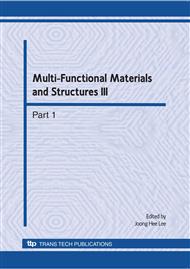p.1187
p.1191
p.1195
p.1199
p.1203
p.1207
p.1211
p.1215
p.1219
Use of Lignocellulosic Components of Sugarcane Bagasse to Obtaining Polymeric Composite Membranes
Abstract:
Currently, several research groups and industries are studying applications for the residues from agribusiness, other than burning them. Thinking about a better use for the sugarcane bagasse, this study aims to obtain membranes of cellulose acetate composite with oxidized lignin, both isolated from sugarcane bagasse. Thus, we obtain a product with higher commercial value, from a natural fiber residue from agribusiness, which has applications in water and effluent treatment, and further contributes to the maintenance of the environment. Macromolecular components of bagasse (hemicellulose, cellulose and lignin) were separated by applying a steam explosion pre-treatment for the removal of the hemicellulose, a basic treatment with NaOH to separate the lignin and obtain crude cellulose pulp. This pulp was bleached and acetylated, and subsequently membranes of cellulose acetate were synthesized, incorporating oxidized lignin to these membranes in order to increase the metal retention capacity of these membranes. The acetylated material was analyzed by IR, confirming acetylation. Degree of substitution was determined by volumetry, yielding a value of 1.7, featuring a diacetate. The synthesized membranes were analyzed by SEM, showing a dense structure. Tests were conducted to evaluate metal retention, and the average capacity of removal was 15% Cu+2 in steady-state experiments. Retention capacity in membranes is 20 times higher than the retention using chromatographic columns separation.
Info:
Periodical:
Pages:
1203-1206
Citation:
Online since:
August 2010
Price:
Сopyright:
© 2010 Trans Tech Publications Ltd. All Rights Reserved
Share:
Citation:


